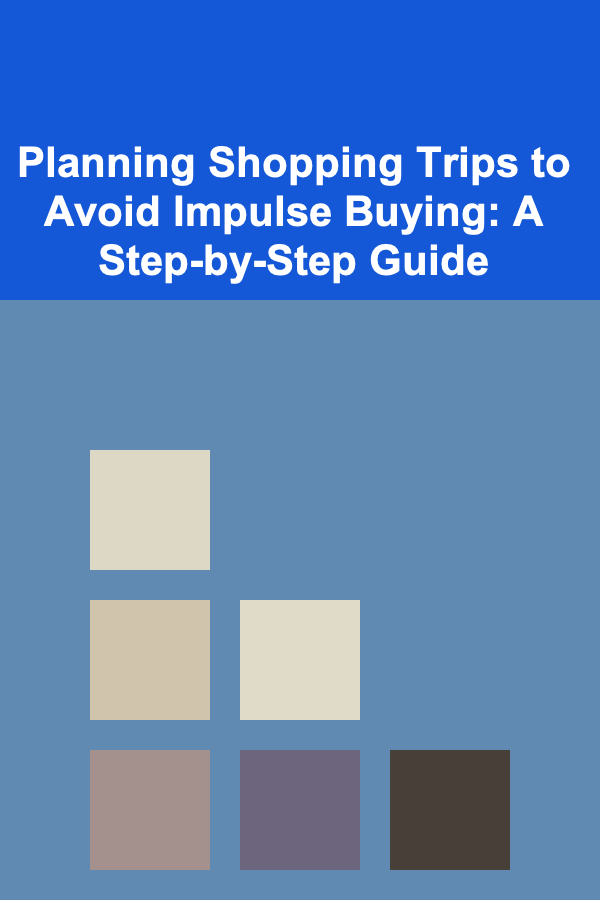
Planning Shopping Trips to Avoid Impulse Buying: A Step-by-Step Guide
ebook include PDF & Audio bundle (Micro Guide)
$12.99$7.99
Limited Time Offer! Order within the next:

Impulse buying can quickly turn a seemingly simple shopping trip into a financial setback. The allure of spontaneous purchases is strong, and before you know it, you're leaving the store with items you didn't need, potentially spending more than you planned. However, with a little forethought and preparation, it is entirely possible to avoid falling into the trap of impulse buying. This step-by-step guide will help you plan your shopping trips effectively, allowing you to stick to your budget and avoid unnecessary purchases.
Set a Clear Budget Before You Shop
The first and most important step in avoiding impulse buys is setting a budget. Having a clear idea of how much you're willing to spend can prevent you from making emotional purchases or overspending.
How to Set a Shopping Budget:
- Track Your Expenses: Review your previous shopping habits to identify how much you typically spend on similar items. This gives you a rough baseline to work from.
- Distinguish Needs vs. Wants: Make a list of what you absolutely need, and separate that from items you'd like but don't necessarily need. Allocate a specific amount for necessities and decide if any extra spending is acceptable.
- Stick to the Budget: Once you've set a limit, commit to it. If you find yourself tempted by an item outside your budget, remind yourself that overspending now could mean missing out on something more important later.
Create a Detailed Shopping List
Having a shopping list is an essential tool to keep you on track. Impulse buys often occur because we wander aimlessly through stores or online shops, distracted by new arrivals or flashy sales.
How to Create a Smart Shopping List:
- Be Specific: Instead of writing vague items like "groceries" or "clothes," list exact items (e.g., "2% milk, avocados, and a red shirt in size medium").
- Prioritize Needs: Put your most necessary items at the top of the list. If you have the option to purchase items in stages (for example, ordering things online), focus on the essentials first.
- Stick to the List: While shopping, stay focused on finding the items on your list. If something isn't on the list, take a moment to assess if it's truly a need or just an impulse.
Research and Compare Prices Ahead of Time
Before heading out to shop, research your desired items. Knowing where to get the best deal can prevent you from giving into store-specific promotions that encourage unnecessary purchases.
How to Do This Effectively:
- Use Price Comparison Tools: Websites like PriceGrabber or apps like ShopSavvy can help you compare prices across multiple retailers, ensuring you aren't tempted by marked-up prices.
- Look for Deals and Coupons: If the item is on sale, check if it's still within your budget. Don't be swayed by discounts unless they truly reflect a significant saving. Sometimes a sale is just a marketing tactic to make you think you're getting a better deal.
- Check Reviews: Ensure the item you're buying is worth the price. Impulse buys often stem from flashy packaging or enticing promotions, but a product may not live up to expectations.
Establish Time Constraints
It's easy to linger in stores or browse online for longer than necessary, and the longer you shop, the more likely you are to be swayed by impulse buys. Setting a time limit helps you stay focused and efficient.
How to Implement Time Constraints:
- Set a Timer: Decide in advance how long you'll spend at the store or shopping online (e.g., 30 minutes for a grocery store or 1 hour for a department store). Set a timer and stick to it.
- Plan for Breaks: If you're shopping in a large store, plan for short breaks to avoid burnout or unnecessary wandering. This ensures you stay focused without feeling rushed or overwhelmed.
Avoid High-Risk Shopping Triggers
Certain situations, stores, or online platforms can increase your chances of making impulse purchases. Understanding your triggers can help you make better decisions and avoid the temptation.
Common Shopping Triggers:
- Sales and Promotions: Stores often use sales to lure customers into buying items they hadn't planned on. While discounts are tempting, always ask yourself if the item is something you truly need, or if it's simply a discounted "want."
- Emotional Shopping: If you're feeling stressed, anxious, or upset, you might be more inclined to make an impulse purchase as a form of emotional release. Try to avoid shopping when you're in this state.
- Browsing Without Purpose: Aimlessly browsing online stores or window shopping can often lead to impulse buys. Instead, stick to your shopping list and avoid browsing outside of it.
How to Avoid Triggers:
- Shop with a Purpose: Before entering any store, know exactly what you need and where it's located. Limit yourself to those areas to minimize exposure to unnecessary items.
- Take Breaks from Marketing: If you're browsing online, use tools like browser extensions to block ads or limit your time spent on shopping sites.
- Leave Emotion at the Door: If you're shopping to cope with a mood, try addressing the emotion in a healthier way before deciding to purchase anything.
Use the "24-Hour Rule" for Non-Essential Purchases
For items that aren't necessities, implement the "24-hour rule." This rule encourages you to wait a full 24 hours before buying anything that isn't on your list. Often, this gives you time to evaluate if you really need the item or if it was just an impulsive desire in the moment.
How to Implement the 24-Hour Rule:
- Wait and Reflect: When you're tempted by something not on your list, step back and give yourself 24 hours to think it over. During this time, consider the cost, how often you would actually use the item, and whether it adds real value to your life.
- Use a Wishlist: If you still want the item after the 24 hours, add it to a wishlist or shopping cart. This will give you the opportunity to revisit it later, allowing more time to decide.
Consider Shopping with a Friend or Accountability Partner
When you shop alone, it can be easier to fall victim to impulse buying. Having an accountability partner---someone who knows your shopping goals---can help you stay on track.
How to Use This Strategy:
- Find a Responsible Shopper: Ask a friend or family member to accompany you, or schedule a virtual shopping trip with someone who knows your budget and shopping habits. They can help remind you to stick to your list and avoid distractions.
- Create Shopping Challenges: Make it a fun challenge to only buy the items on your list, or set a goal to leave the store with everything in your cart matching your list. Competing in a friendly way can make shopping feel more purposeful and intentional.
Evaluate Your Purchases at Checkout
Even after following all the steps above, it's important to evaluate your purchases at the checkout. Impulse buys often occur during the checkout process when we're faced with last-minute temptations or add-ons.
How to Evaluate:
- Double-Check Your List: Before completing the transaction, go through your shopping list and make sure everything in your cart is necessary. Remove any unplanned items that were added without careful thought.
- Ask Yourself "Do I Really Need This?" Before paying, take a moment to ask if the item will truly benefit you or if it's just a fleeting want.
- Consider Future Financial Goals: If you're tempted to buy something unnecessary, think about how that money could be used for a future goal---whether it's saving for a larger purchase or paying down debt.
Use Cash Instead of Cards
Using cash is a simple but effective way to limit your spending and avoid impulse buying. It's harder to overspend when you physically see the cash leaving your hands.
How to Implement:
- Withdraw a Set Amount: Before heading to the store, withdraw the exact amount you intend to spend. This acts as a built-in limit and helps you stay within your budget.
- Leave Credit Cards at Home: If you know you have difficulty with impulse purchases, consider leaving your credit cards at home. This removes the option to buy on impulse when your cash runs out.
By following these steps, you can plan your shopping trips effectively, minimize impulse buys, and stick to your financial goals. The key to success lies in preparation, mindfulness, and self-discipline. Whether you're shopping in-store or online, these strategies will help you become a more conscious, intentional shopper. The next time you head out, arm yourself with these steps to avoid unnecessary purchases and keep your finances on track.
Reading More From Our Other Websites
- [Home Space Saving 101] How to Make Your Bedroom Feel Bigger with Simple Space-Saving Tricks
- [Personal Investment 101] How to Understand What Are Futures and Options and When to Use Them
- [Home Cleaning 101] How to Clean a Bathroom: Tips for Tackling Tiled Surfaces, Fixtures, and More
- [Organization Tip 101] How to Use Visual Aids for Daily Schedules and Rules
- [Weaving Tip 101] How to Experiment with Inverted Weave Structures to Produce Sculptural Fabric Forms
- [Personal Care Tips 101] How to Make Your Own Exfoliating Body Scrub at Home
- [Home Budget Decorating 101] How to Find Affordable Decor for Every Room in Your Home
- [Home Storage Solution 101] How to Maximize Your Laundry Room with Clever Hanging Storage Ideas for Small Spaces
- [Home Maintenance 101] How to Maintain Your Home's Plumbing System and Avoid Leaks
- [Biking 101] The Ultimate Guide to Choosing the Right Bike Repair Stand

How to Optimize Images and Media for Faster Load Times and Better UX
Read More
How to Sell Handmade Macrame Items on Etsy: A Comprehensive Guide
Read More
How to Work with Local vs. International Dropshipping Suppliers: An Actionable Guide
Read More
How to Crochet a Scarf: A Cozy Project Checklist
Read More
10 Tips for Mindful Eating Using Meditation
Read More
10 Quick Pilates Exercises for Your Busy Day To-Do List
Read MoreOther Products

How to Optimize Images and Media for Faster Load Times and Better UX
Read More
How to Sell Handmade Macrame Items on Etsy: A Comprehensive Guide
Read More
How to Work with Local vs. International Dropshipping Suppliers: An Actionable Guide
Read More
How to Crochet a Scarf: A Cozy Project Checklist
Read More
10 Tips for Mindful Eating Using Meditation
Read More